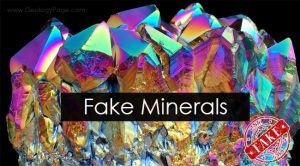
The fake minerals are minerals (or gems, that is to say outstanding minerals) not natural, man-made. This can be a natural mineral transformed by man into another, or an entirely artificial mineral. Also referred to as false to the synonyms. In short, counterfeiting may be partial (sample processed) or total (sample created by humans) or cover the name given to the sample. They have always existed, their marketing is growing very rapidly.
There are now numerous examples of fakes in mineralogy and gemology. If there are criteria for authentication of minerals, it is sometimes difficult to distinguish between fake and genuine ones. Fake samples are sold for real deception, but when the infringement is announced or found, it may have a financial interest, decorative or teaching for the buyer.
Non Natural mineral can be made by: Man Made Crystals, Coated Crystals, Chemical Reaction to Crystals, Mechanic Alteration of Crystals, Irradiation of Crystals, Heat Treatment of Crystals, Dyeing of Crystals.
List of fake Minerals
Aqua Aura Quartz
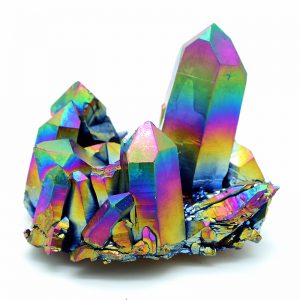
Aqua Aura Quartz is a beautiful bright blue color, but this color is not natural. It’s surface has been coated with metal to give them an iridescent metallic sheen. Crystals treated this way are used as gemstones and for other decorative purposes. Possible coatings include gold (resulting in a stone called aqua aura), indium, titanium, niobium and copper. Other names for crystals treated so include; angel aura, flame aura, opal aura or rainbow quartz.
Aqua aura is created in a vacuum chamber from quartz crystals and gold vapour by vapour deposition. The quartz is heated to 871 °C (1600 °F) in a vacuum, and then gold vapor is added to the chamber. The gold atoms fuse to the crystal’s surface, which gives the crystal an iridescent metallic sheen.
Bismuth
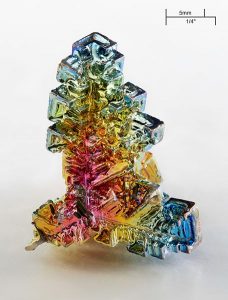
Bismuth does occur in nature, but usually as dull gray amorphous (“without crystal structure”) lumps and often accompanied by yellow or green oxidation products.
These crystals are made in a laboratory, by allowing super cooled liquid bismuth to crystallize. “How To Make Bismuth Crystals At Home”
Cermikite
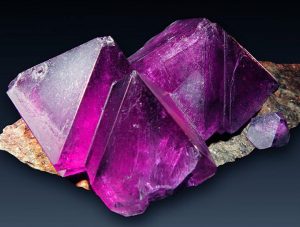
This is not a natural mineral, but instead is probably laboratory-grown chrome alum (aluminum chromium sulfate) or regular, colorless alum which has been crystallized in the presence of a dye. Other laboratory grown specimens of different colors have also been called cermikite.
Nickel Crystals
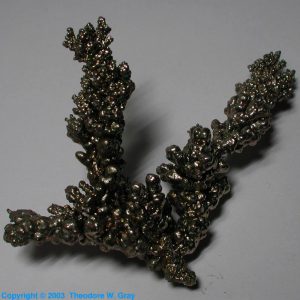
Nickel crystals can form on the wires used in the electrodeposition process. These fakes are easy to spot. Natural nickel crystals are exceptionally rare (usually found only in meteorites), and when they do occur, they are very small (a 1 mm natural nickel crystal is considered large).
Carborundum
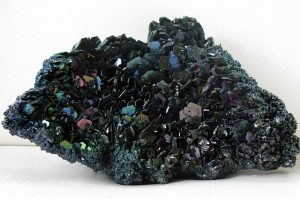
It does occur in naturally as well, as the mineral moissanite, but it is very rare, and crystals are almost always tiny or microscopic.
Carborundum (silicon carbide) is produced artifically in large quantities as an abrasive. Most is crushed and used in griding grits and abrasive papers. This specimen shows coarsely crystallised hexagonal plates of silicon carbide, with typical rainbow irridescent surface colours.
Galena Geodes
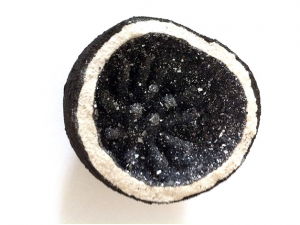
They are not naturally formed and are a man made product. They have been created using a natural geode which has been filled in with galena.
Green Quartz
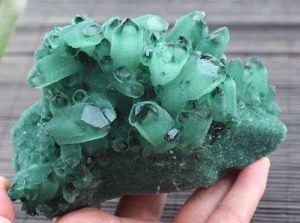
Green quartz can be produced in the lab by a modification of the process used to manufacture large, high-quality quartz crystals for electronics applications. The process involves heating the quartz with water under high pressure. This causes the quartz to recrystallize. If other substances are present these might be included into the new crystals.
Brightly colored Obsidian
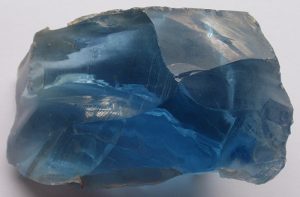
Obsidian is a naturally occurring volcanic glass formed as an extrusive igneous rock.
It is produced when felsic lava extruded from a volcano cools rapidly with minimal crystal growth. Obsidian is commonly found within the margins of rhyolitic lava flows known as obsidian flows, where the chemical composition (high silica content) induces a high viscosity and polymerization degree of the lava.
Obsidian comes in black, brown, gray and several combinations such as white and black “Snowflake” obsidian and brown and black “Mahogany” obsidian.
Fake is brightly colored Reds, Blues, Greens
This is a small list of fake minerals but there are a lot, Please be cautious, So try to find reliable dealers.
Reference:
Wikipedia: Fake minerals and fossils
Wikipedia: Fake minerals
Fake Minerals
The-Vug










